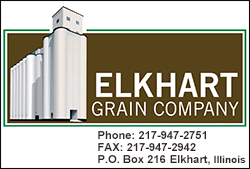|
 Yields have been on a phenomenal run over the last 30 years. Many
improvements in genetics, equipment, timely operation, and support
service improvements have all contributed to this run. Yields have been on a phenomenal run over the last 30 years. Many
improvements in genetics, equipment, timely operation, and support
service improvements have all contributed to this run.
However, there is an old adage which states something like
“production isn’t the only measure of profit.” In a recent article
from Gary Schnitkey and Darrel Good, University of Illinois
Extension Specialists, income calculations were based on 203 bushel
corn and 61 bushel soybean averages. Those are some lofty numbers
which are about 10% over 10 year average figures for Logan County.
Another side to the profit triangle is the markets for selling
grain. Average price estimates for 2017 were $3.60 corn and $10
soybeans. Again lofty numbers for historical prices. The third part
of profit is the expenses for producing the crop. Costs of all
inputs except land cost totaled $521 per acre for corn and $291 per
acre for soybeans. Those figures are before land costs, in many
cases this would be the cash rent figure.
 Schnitkey and Good calculated at half corn and half soybeans
produced, a cash rent of $240 would leave $11 per acre for return to
the tenant. That’s if everything plays out with production, price
received, and staying at the estimated cost level.
Historically, this would be a razor-thin margin to provide for the
living expenses for the farm family. The last sustained period of
these types of returns was about 35 years ago. The main differences
are that the interest rates are about one-third of what they were
then, and we are dealing with a much larger scale in terms of acres
and dollars invested and received. The old “rule-of-thumb” was you
needed to gross $400 per acre on corn and about 85% of that on
soybeans. Essentially the numbers have doubled in this period to get
to the same levels of profits.
The livestock sector has traditionally been able to help balance
farm income. Today, not many farms have any livestock on them. The
prices received for sheep and cattle have been bright spots in the
livestock markets. Surely you’ve noticed the prices paid for eggs,
milk, and pork products in the grocery store. Eggs and milk are to
the point of ridiculous in many cases, running half the cost of
producing them.
[to top of second column] |

All “gloom and doom?” Not really. We’re coming off of an era of
unprecedented profits. Those who saved some back are weathering the
situation better. Many replaced equipment, and thereby reduced some
of the costs associated with their operations. The scale of
production has also increased with farm size expanding for the
commercial producers. This allows for smaller profit margins per
acre and still maintaining some semblance of making a living. Input
costs also continue to decline, but not as fast as the income side
has faded.
Specialty production and sales also are a bright spot. Community
Supported Agriculture and Farmer’s Markets offer small-scale
opportunities for increasing income. The same goes for specialty
livestock markets. These don’t offset expenses for large-scale
commercial operations, but do offer some opportunities for producers
of all sizes to have concentrated income on a few acres.
As the spring planting season approaches, everyone involved in
agriculture is an optimist. The thought of nurturing a crop through
the season, and producing a bountiful harvest, is why producers
continue to ride the roller coaster of farm income. And, if anyone
can figure out how to make it work, it would be the farmer.
|